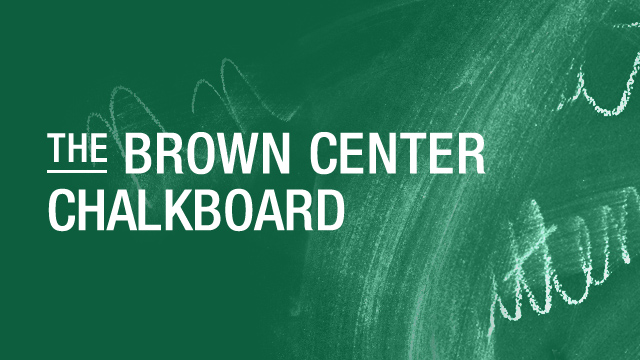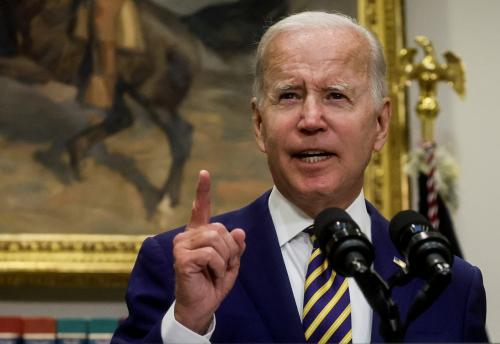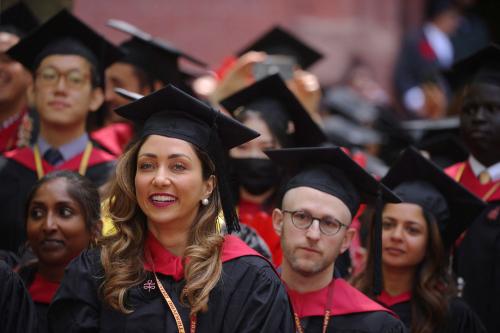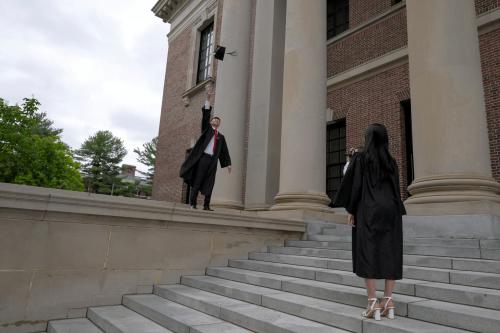The U.S. Department of Education (ED) recently clarified which graduate programs qualify as “professional” for higher federal loan limits under the One Big Beautiful Bill Act (OBBBA). Almost immediately after ED made its decision, social media lit up with claims certain careers such as teaching and nursing had been “removed” or that ED was claiming those careers were not professions.
The online reaction was partially warranted. This decision, which is still pending and may change following a public comment period, has direct implications for prospective graduate students who need to borrow money to finance their training. By extension, this decision could also impact the universities that offer graduate programs and the supply of new workers into affected occupations.
But part of the online response was inaccurate and misleading, which could lead many young people to make rash decisions under false pretenses. And their decisions could meaningfully shape their career choices, borrowing decisions, and future earnings potential. In other words, this is a clear example of how easily misinformation spreads via social media, and how critical it is for borrowers to have clear, accurate information when making weighty financial decisions.
Furthermore, OBBBA, the negotiated rulemaking process, and the online reaction highlight the need for a better framework to consider loan eligibility. Graduate loan policy needs to strike a delicate balance between ensuring access to graduate training to meet workforce needs and safeguarding against excessive borrowing that leaves students with unmanageable debt.
Why did OBBBA implement loan limits?
When OBBBA passed over the summer, it implemented significant limits on how much graduate students can borrow. Proponents of loan limits have long argued that, under prior federal policies, graduate students had access to essentially unlimited borrowing, which resulted in universities charging higher tuition and students taking on unsustainable debt that they won’t be able to repay. This is sometimes referred to as the “Bennett hypothesis.” Whether the hypothesis is valid is still an open question. Some institution-level analyses find no evidence of tuition changes for law, business, or medical schools, though analyses looking at individual students’ borrowing argue colleges did increase tuition when graduate borrowing limits historically expanded.
Graduate students do borrow a lot. Roughly 47% of new student loans are for graduate school, up from 33% in 2010. The median cumulative graduate program debt was $70,300 in 2020. Graduate students have low loan default rates, as the graduate training itself enhances individuals’ future earnings (and ability to manage their debts). But debt repayment can still impose a financial burden; about 57% of master’s degree graduates’ additional earnings go to student loan repayment the first few years after completion. OBBBA sought to curtail the growth in graduate loan debt.
How did OBBBA change graduate loan limits?
There were graduate student borrowing limits on unsubsidized loans in place before OBBBA. All students, regardless of program of study or graduate degree level, could borrow up to $20,500 each year. But these limits did not meaningfully constrain borrowing in practice, as the Grad PLUS program allowed nearly unlimited borrowing up to the “cost of attendance” at a graduate program (inclusive of tuition, fees, and housing/living allowances). In 2021-22, about 30% of federal graduate loans were Grad PLUS loans.
The largest OBBBA change was the elimination of the Grad PLUS program, which means the established borrowing limits are now going to be enforced. Graduate students attending programs with costs exceeding those limits will now either have to pay more out of pocket or use private student loans.
The bill also changed the unsubsidized loan limits for graduate students that now vary depending on whether a student’s degree program is classified as “professional” or not. For professional degree programs, the annual limit increased from $20,500 to $50,000 and the aggregate limit increased from $138,500 to $200,000.1 For general graduate study, the annual limit is unchanged from $20,500, with an aggregate limit of $100,000. With the elimination of Grad PLUS, the delineation between a graduate and professional degree has become the only path to access more federal student loans.
Why did ED have to define professional programs?
When Congress leaves ambiguous language in a bill, executive agencies need to issue rules clarifying how to implement that legislation. OBBBA’s text described programs eligible for higher loan limits as “professional” without specifying what programs they meant. There are many reasons to leave legislative language ambiguous, including needing to get a bill passed and Congress’ recognition that they do not have the policy expertise to define every component of a bill.
Enter the negotiated rulemaking process (or “neg-reg”). ED convened a committee with representatives from different types of universities and borrowers, as well as from student loan administrators, legal assistance organizations, and the states. The committee, under the guidance of experienced federal negotiators (who have presided over rulemaking under multiple presidential administrations), reviewed proposed language around defining professional programs (and other ambiguous language in OBBBA).2 This committee’s recent decision is what sparked the online reaction.
Why the outrage?
Negotiated rulemaking is a complicated (and kind of boring) process. So, it’s not surprising that there would be confusion about what it meant when ED announced the committee’s consensus around “professional degree” definitions.
Some borrowers believed their degree had been “removed” from eligibility, when in reality ED slightly expanded an existing (but rarely used) list of professional programs. The nuance here matters: ED added programs that were in the same field of study as the existing list and met licensure and program length requirements. Yet, many occupations that had advocated for the inclusion of pertinent degrees on the “professional” list, such as nursing and teaching, remain outside the definition.
It is reasonable for professionals to argue that their degrees should be eligible for higher borrowing limits, but misstating ED’s neg-reg process and spreading misinformation about loan limits can cause real harm. There are enough moving pieces to how loan limits are changing, without adding additional confusion to how borrowers navigate information. ED issued a fact sheet this week responding to the public discourse, and some social media influencers have put together explainers about misperceptions. These efforts help, but clear communication from university financial aid offices and ongoing media reporting to correct these inaccurate narratives is critical to ensure prospective (and current) borrowers understand how OBBBA loan limits affect their ability to pay for graduate school.
What does the proposed definition of professional programs mean for students and schools?
Many prospective graduate students will face lower access to loans post-OBBBA. Jordan Matsudaira at the Postsecondary Education & Economics Research (PEER) center has written excellent briefs describing current graduate borrowing and the potential impacts of OBBBA. He looks at students in programs that are and aren’t on ED’s proposed “professional” program list and estimates about 370,000 or 26% of all graduate students currently borrow above the OBBBA limits. Notably, an even larger share of students currently enrolled in professional degrees exceed the higher OBBBA limits—38% of these students (and 71% of dentistry students!) borrow more than $50,000.
While a sizeable share of students enrolled in graduate programs currently borrow above the $20,500 annual threshold, borrowing varies considerably across programs. Median annual borrowing for a registered nursing graduate degree is about $18,400, but the 90th percentile borrows above $33,500. Students enrolled in education master’s programs borrow an average of about $15,300 each year, but 13% exceed the OBBBA annual limit.
Regardless of field of study, loan limits may still affect whether and where students choose to study. Since prospective students will no longer have access to Grad PLUS, they have to cover both tuition and fees and living costs with their limited unsubsidized loans, which may divert students away from more expensive private universities and higher cost-of-living areas (though that assumes less costly colleges have capacity to enroll more students). Still other prospective students will decide not to enroll in graduate school, which may cause labor market shortages or affect the composition of the workforce. Some occupations not included in the “professional” designation such as teaching and social work already face labor market shortages, and reduced graduate enrollment in those fields could exacerbate these challenges.
Graduate programs have also historically been a revenue stream universities can use to cross-subsidize undergraduate education. If schools lose graduate students, or lower graduate prices to meet loan limits, they may have less revenue to spend on undergraduate financial aid to improve affordability.
What should determine borrowing limits?
This discourse raises a bigger question. What should determine borrowing limits? Should they reflect program costs, which vary widely by length, faculty salaries, and equipment needs? Should they account for living expenses, which differ across regions? Should they adjust for inflation over time? Or should limits hinge on expected earnings and repayment capacity, which vary across fields of study? And how much do federal borrowing limits affect the prices colleges charge? These questions aren’t new—they echo longstanding tensions in federal loan policy between access, affordability, and risk.
Whether OBBBA’s delineation by professional or graduate program is an appropriate differentiation hinges on how much that definition reflects reasonable cost drivers—but that is a complaint to take up with Congress, not ED.
What comes next
The list of professional programs the neg-reg committee approved will be formally proposed as rules in the coming weeks (expected in Jan. 2026). The Notice of Proposed Rulemaking will have at least a 30-day public comment period, and ED will aim to respond to those comments and post the final rule by July 1, 2026 (when most provisions are written to go into effect). ED may change the rule in response to public comments. Effective public comments (see this Brookings post for tips) would offer concrete evidence around the impact of the proposed rule on graduate enrollment and the workforce, and assess whether it is “arbitrary or capricious.” By law, ED must respond to comments, and comments are also used as evidence if there are legal challenges to agency rules (there often are).
In theory, the 2024 Supreme Court decision in Loper Bright Enterprises v. Raimondo awards more judicial discretion to whether an agency has the authority to issue a rule. However, ED has based its proposed definition of a professional graduate program on the existing list of professional graduate programs long used by the federal government and directly referenced by Congress in drafting the bill. Their expansions to that list (even if not as expansive as some may wish) are reasonably connected to that underlying definition. It seems unlikely that legal review would strike down the rule for not being more expansive.
For now, borrowers and higher education institutions should plan around ED’s proposed definition. Any expansion of eligible programs will probably require future rulemaking—or, more likely, congressional action. In the meantime, clear communication from ED and institutions will be essential to help students navigate these changes without falling prey to misinformation.
-
Footnotes
- Related, OBBBA implemented a $257,000 total lifetime borrowing cap per student, though in practice undergraduate aggregate borrowing limits already exist that would effectively retain students’ eligibility for the full graduate or professional borrowing limit. That is, a dependent student who borrows the maximum of $31,000 in federal loans for their undergraduate studies would have a $226,000 lifetime limit leftover, which is greater than the aggregate graduate or professional loan limits. An independent student who borrows the maximum of $57,500 for undergraduate studies would have $199,500 leftover lifetime limit, which is greater than the aggregate graduate limit, and $500 less than the professional limit.
- For example, the recent neg-reg committee also clarified how currently enrolled students would be impacted, answering many current and prospective students’ questions about how loan limits would impact them. Anyone who receives a federal student Direct loan for a program of study prior to July 1, 2026, will (a) retain eligibility for PLUS loans (even if the loan they took out prior to July 1, 2026 was not a PLUS loan); and (b) face the existing annual and aggregate unsubsidized loan limits while they continue their program (with guardrails on how long students have to complete that credential). NASFAA has a helpful flowchart explaining how continued eligibility works.
The Brookings Institution is committed to quality, independence, and impact.
We are supported by a diverse array of funders. In line with our values and policies, each Brookings publication represents the sole views of its author(s).








Commentary
Defining professional programs: Why evidence and clarity matter in ED’s rulemaking
November 26, 2025